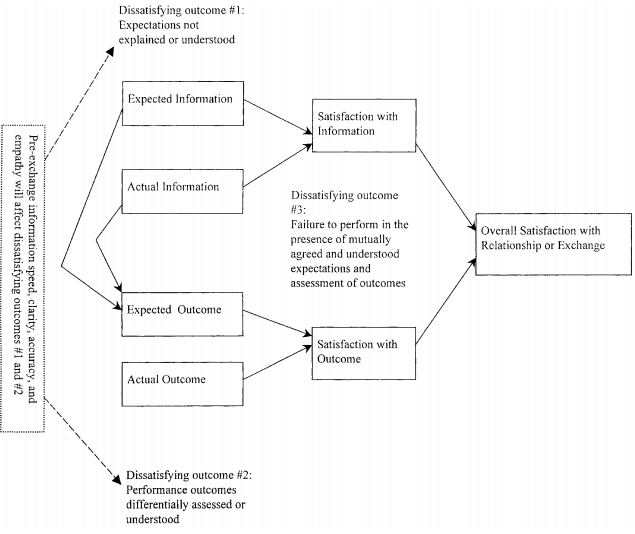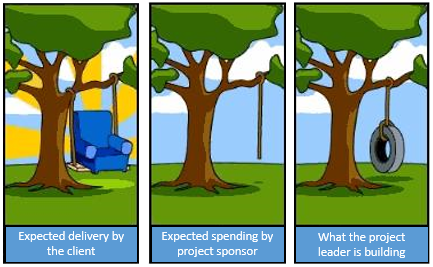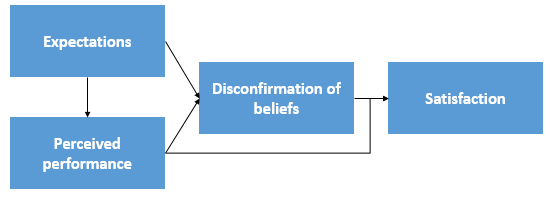Stakeholder Expectations Management
(→SMART requirement agreement) |
|||
| Line 63: | Line 63: | ||
To make | To make | ||
| − | ===SMART | + | ===SMART requirements agreement=== |
A requirement is nothing more than an expected outcome of the project. Requirements are an important part of setting expectations with a stakeholder. In the absence of facts and details, the stakeholder will interpret and make up assumptions. Everything should be stated in the requirements. If it is not stated, it is not committed to be completed. | A requirement is nothing more than an expected outcome of the project. Requirements are an important part of setting expectations with a stakeholder. In the absence of facts and details, the stakeholder will interpret and make up assumptions. Everything should be stated in the requirements. If it is not stated, it is not committed to be completed. | ||
Revision as of 20:29, 16 September 2016
Dear reviewer, thank for your time. If it was feasable for you, it would be great if you could provide me feedback on Sunday, so that the article will be at a more advanced stage! Thanks *** work in progress - sources and quotations are still not mentioned in the article.***
Stakeholder satisfaction is a main factor in a project success. Therefore, for a project manager is vital to have under control the satisfaction of the different stakeholders.
Stakeholder satisfaction is impacted by multiple factors during a project and it can be hard to directly manage it, but it can be improved by managing and aligning the stakeholder expectations. In fact as illustrated by the expectancy disconfirmation model the stakeholder satisfaction is given by the discrepancy between the perceived performance of and the prior expectations about the outcomes.
Expectations usually differ between the different parties in a project and as the number of stakeholders arises aligning becomes more and more difficult.
This article will present a set of tools to identify and manage stakeholder expectations, both in the planning and execution phases. The tools will be divided in proactive tools, to use in the planning phase and reactive tools, to support the project execution.
Contents |
Project Management and Stakeholder Management
Stakeholders are defined by the ISO 21500 standard as "a person, group or organisation that has interests in, or can affect, be affected by, or perceive itself to be affected by, any aspect of the project" [ISO21500. 2012. Guidance on Project Management. International Organization for Standardization]. Therefore, any project leader should identify analyse and categorize all the key stakeholders defining which interests they have and how important they are for the completion of the project.
TALK ABOUT PM performance domain?
Stakeholder Management is used to describe the process of identifying, assessing and building a relationship with the stakeholders. [How to do projects]
Different theories provide different criteria for project success; however recent literature is converging on defining the project success as a result of stakeholder satisfaction. Other tools like the triple constraint (http://apppm.man.dtu.dk/index.php/Project_Management_Triangle) should be used when monitoring and controlling to check whether the project is deviating from its baseline and business criteria should be taken into account. But these are not the right indicators to evaluate if a project is a success or a failure. [1]
The importance of expectations in stakeholder satisfaction
From the previous section we understood how important ending the project with satisfied stakeholder is for the project success. In this section two theories on the elements will be presented to understand how managing stakeholder expectation is the first step in stakeholder satisfaction.
Expectation confirmation theory
Expectation confirmation [2] theory is a cognitive theory developed in the '70 by Richard L. Oliver. It was developed in a marketing literature but from there it was applied in multiple fields since its versatility and simplicity. The first application was to explain post-purchase or post-adoption satisfaction. This effect is mediated through positive or negative dis-confirmation between expectations and performance. If a product outperforms expectations (positive dis-confirmation) post-purchase satisfaction will result. If a product falls short of expectations (negative dis-confirmation) the consumer is likely to be dissatisfied. [3] Although this gap model of satisfaction was developed primarily within marketing to explain customer satisfaction, it is likely that the relationships apply to other stakeholder groups (Taylor, 1993)
Stakeholder satisfaction model / will probably be eliminated
Stakeholder satisfaction model was developed in 2001 as an extension to the expectation confirmation theory. In this model, satisfaction is thought to be a two-phase process of:
1) communicating accurate information regarding realistic expectations of the exchange or relationship, as well as accurate depictions of actual performance
2) providing actual performance, which equals or exceeds expected performance.
 Figure 2: Stakeholder satisfaction model
Figure 2: Stakeholder satisfaction model
Note: this section will be concluded how this model can bring to a better understanding of the relation between expectations and satisfaction and provide a landscape in which the tools presented in section 3 will be connected together.
Toolbox
Proactive toolbox
Stakeholder inventory
The first step of managing the stakeholders expectation is to have the complete picture of who is a stakeholder in the project.
Stakeholder analysis
From this first list is important to prioritize the stakeholders in base at their relationship with the project. For the purpose of this article, the theory background and detailed explanation on how to use the tool will not be presented. The page Stakeholder Analysis explains in depth the concept and it's application.
Reverse brainstorming
Trying to understand the stakeholder expectation in a project, a main issue can be found in the lack of a clear vision from the stakeholder of its desires. Reverse brainstorming solves the problems of direct questioning and the singular approach by exploring multiple factors in reverse. This encourages more creative thought. Instead of asking what a problem is and how to fix it, reverse brainstorming asks “What causes the problem?” or “What achieves the exact opposite effect of what we’re looking for?” Doing so encourages more participation and outside-the-box thinking. With reverse brainstorming, the question is not “How do I solve this?” but rather, “How do I cause this to be a problem?”[4]
Prototyping
A prototype is an early sample, model, or release of a product built to test a concept or process or to act as a thing to be replicated or learned from. To make
SMART requirements agreement
A requirement is nothing more than an expected outcome of the project. Requirements are an important part of setting expectations with a stakeholder. In the absence of facts and details, the stakeholder will interpret and make up assumptions. Everything should be stated in the requirements. If it is not stated, it is not committed to be completed.
| Specific | Measurable | Attainable | Realistic | Time-bound | |
| Explanation | a good requirement is specific and not generic. It should not be open to mis-interpretation when read by others. | this answers whether you will be able to verify the completion of the project. You should avoid signing up for any requirement that cannot be verified as complete. | the requirement is physically able to be achieved given existing circumstances | answers whether the requirement is realistic to deliver when considering other constraints of the project and requirements | specify by when or how fast a requirement needs to be completed or executed |
Reactive toolbox
Issue log
When analyzing stakeholder expectation and issue represents the distance between the stakeholder expectation and the reality of the project. An issue log, in general project management term, is a documentation element of software project management. An issue log contains a list of ongoing and closed issues of the project. While issue logs can be viewed as a way to track errors in the project, the role it plays often extends further. Issue logs can be used to order and organize the current issues by type and severity in order to prioritize issues associated with the current milestone or iteration.[5]
Interest based negotiation
Integrative bargaining (also called "interest-based bargaining," "win-win bargaining") is a negotiation strategy in which parties collaborate to find a "win-win" solution to their dispute. This strategy focuses on developing mutually beneficial agreements based on the interests of the disputants. [6]
Project Management Triangle
The Project Management Triangle (called also Triple Constraint or the Iron Triangle) is a model of the constraints of project management. Following the definition of a new expectation this tool can support the understanding of how the rest of the project will be impacted to satisfy this new expectation. In fact one side of the triangle cannot be changed without affecting the others.This triangle reflects the fact that the three properties of a project are interrelated, and it is not possible to optimize all three – one will always suffer. [7]
RACI Matrix / will be probably removed
The Responsibility Assignment Matrix (RACI Matrix) focuses on clarifying what stakeholders roles and responsibilities are in a context of a specific task or process step. It classifies stakeholders according to one of the following roles for specific project activities:
Responsible: The stakeholder performs the project work activities.
Accountable: The stakeholder is accountable to the sponsor or to the customer for the result of the work activities.
Consulted: The stakeholder is asked for opinions on objectives, assumptions, constraints, or methods of planning and developing products or process due to expertise or position in the organization.
Informed: The stakeholder is notified of the outcome of project decisions.
Using this matrix, the project leader can control which stakeholder should be informed or consulted in regards to a certain task

